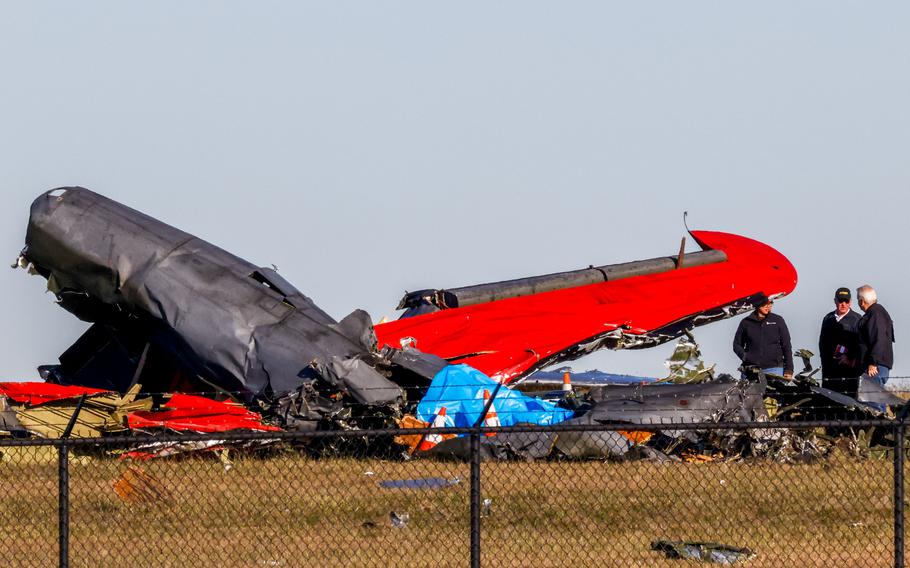
Officials, including those from the Federal Aviation Administration, survey damage from a Boeing B-17 Flying Fortress and a Bell P-63 Kingcobra crash a day earlier at the Dallas Executive Airport on Sunday, Nov. 13, 2022. (Liesbeth Powers, Dallas Morning News/TNS)
DALLAS (Tribune News Service) — Newly released audio from the Wings Over Dallas air show gives insight into the moments before and after the collision that killed six airmen and destroyed two WWII-era aircraft in November.
A 36-minute air traffic control recording The Dallas Morning News obtained from the FAA contains conversations between multiple pilots and the show’s air boss, who is responsible for air show operations on the taxiways, runways and demonstration area.
The Nov. 12 midair collision at Dallas Executive Airport involved a Boeing B-17 Flying Fortress and a Bell P-63 Kingcobra. One pilot was in the P-63, and two pilots and three crew members were in the B-17.
The Commemorative Air Force, which hosted the Wings Over Dallas show, identified those who died as Terry Barker, Craig Hutain, Kevin Michels, Dan Ragan, Len Root and Curt Rowe. No one on the ground was injured or killed.
Videos from spectators posted on social media show the P-63 banking and striking the B-17, which was flying straight. The impact disintegrated the P-63 and cracked the B-17 in two, with the front half of the fuselage exploding in flames as it hit the ground.
‘Knock it off. Roll the trucks.’
In the minutes before the collision, the air boss asks the bombers, including the B-17, if they have the fighters in sight and if the fighters see the B-17, according to aviation expert Richard Levy, who reviewed the audio at request of The News.
“It seems there is a visual contact made between aircraft,” Levy said.
The air boss directs the fighters, including the P-63, to fly along the 500 foot line away from spectators and the bombers to do the same from the 1,000 foot line.
He tells the fighters to come through first and ahead of the bombers, Levy said.
“Fighters will be a big pull and up to the right,” was the last transmission from the air boss before the crash at 1:21 p.m.
A moment of silence in the audio occurs before the air boss, with urgency in his voice, says “Knock it off. Knock it off. Roll the trucks. Roll the trucks.”
He tells some aircraft to hold position and seemingly diverts others to Lancaster Airport nearby as emergency responders and fire engines began responding to the crash.
When will a detailed report be released?
The National Transportation Safety Board released its preliminary report Nov. 30.
The four-page report did not determine a cause for the crash, but provided details about the minutes and maneuvers leading up to the collision.
The report confirmed the instructions heard in the audio about traveling along the 500 and 1,000 foot lines but when the fighter formation approached the performance area, the report says, the P-63 was in a left bank and collided with the left side of the B-17, just behind the wing section.
A full report on the collision is expected to take 12 to 18 months.
©2023 The Dallas Morning News.
Visit dallasnews.com.
Distributed by Tribune Content Agency, LLC.